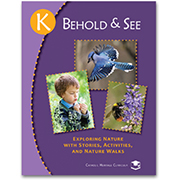The Behold and See science series for grades one through seven is written with Catholic homeschooling families in mind, and you can read my review of that series here. However, the newest addition to the series, level K, can be used by all Christian families with the exception of one paragraph, so I review this course separately to highlight the potentially broader audience.
In addition, while Behold and See K targets kindergarten level, it can easily be used with preschoolers as well as first and second graders. You will want to expand upon topics for students in the primary grades.
Nature walks are the mainstay of this course, although a section with Rainy Day Activities offers alternatives when weather or other situations make a nature walk impractical. Nature walks might take place in natural settings, but they might also be in your backyard or at a pet store, farm, zoo, animal shelter, garden nursery, aquarium, science museum, or other places.
Simple lesson plans provide for one planning day and three activity days each week, although these are all very flexible. Each week’s lesson focuses on one particular living thing but also introduces a few related flora or fauna. For example, the squirrel is featured in the lesson on rodents, the oak tree is featured in the lesson on deciduous trees, the cow is featured in the lesson on farm animals, the duck is featured in the lesson on water birds, and the tiger is featured in the lesson on the rainforest.
For each week’s lesson, you will read aloud the Creature Feature or Nature Feature from the course book allowing your children to study the pictures and ask questions. Next, you will read aloud about and look at pictures of related creatures or plants. Children will need to listen closely as you read the second part since it asks them to indicate the correct image that matches each description by drawing a brown circle, a gray square, an orange triangle, etc. around the correct image. On this same day, you can also watch one or more of the recommended video clips that you will find on a list at the back of the book. These videos bring the topics to life, so be sure to check them in advance to select which ones you want to use as well as ensuring they work. Video clip URLs are provided for most lessons. (It would be more helpful to have these links posted on a webpage so that parents don’t have to type in the URLs and so that links can be updated if needed.)
The second lesson day each week is for the nature walk itself. Nature Walk Take-Along Sheets that you will remove from the book show colorful drawings of a selection of items such as a plant, an animal, a reptile, an insect, or a bird along with items such as a tree stump, a birdhouse, a gray rock, animal prints, a cloud, or icicles. Each unique sheet gives children a number of items to search for on their nature walk. Additional suggestions are sometimes included. For example, one lesson adds an alphabet search (children hunt for items that represent each letter of the alphabet). Two other lessons suggest a scavenger hunt and an “I Spy” game.
On the third lesson day for each week, children can color the full-page image in the book while you read aloud from one of the many suggested fiction or non-fiction books listed on page 188 and 189. You can also read aloud the Bible verse that is at the bottom of each coloring page.
I mentioned the one paragraph of Catholic content that I found at the bottom of page 62. This paragraph explains a legend of how the ladybug got its name. Briefly, a farmer's crops were infested and he prayed to Mary for help. A new insect appeared that destroyed the infestation, and he called the new insects ladybugs in honor of Our Lady - Mary. Because non-Catholics don't generally use "Our Lady" when referring to Mary, or honor Mary in the same way, parents can skip this paragraph if they wish.
As you can see planning is required. Each week, you will need to figure out the most suitable place to go for the walk, and you’ll need to acquire a read-aloud book of your choice. But planning can be done weeks in advance and shouldn’t be too difficult. Feel free to use lessons in a different order to suit the weather and the availability of nature walks or field trips.
The idea of nature walks is appealing to many homeschoolers, but keeping children tuned in while on a nature walk can be a daunting chore. Having the identification sheets or other activities helps children stay focused and observant. Children won’t find everything on their sheets, but you might have some great discussions about whether or not a certain observed item will count or whether there might be a potential substitute in your area.
Behold and See K seems perfect for homeschool families with younger children who want to explore the outdoors without making it too complicated.








